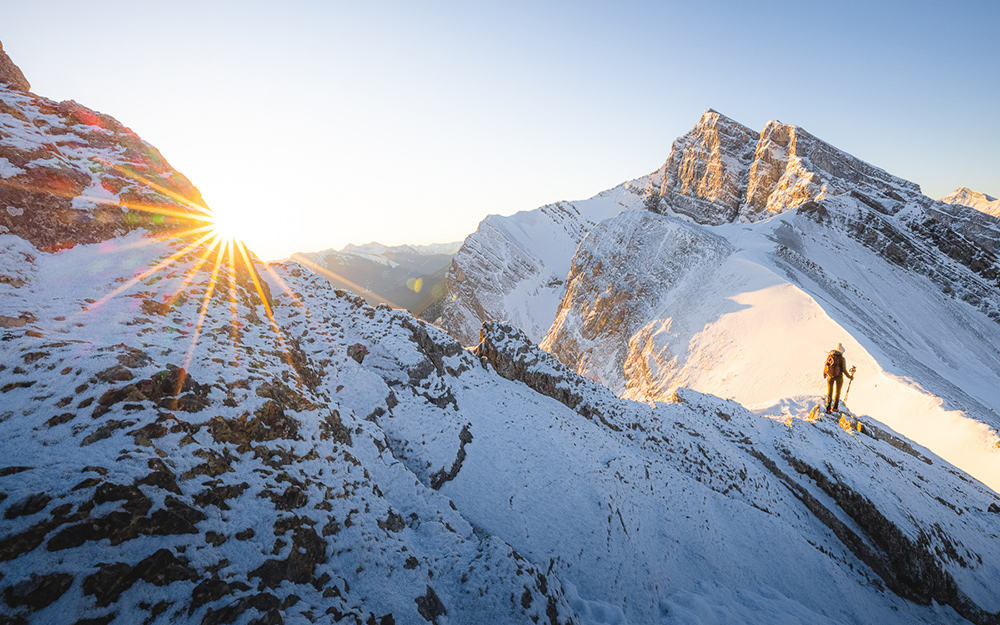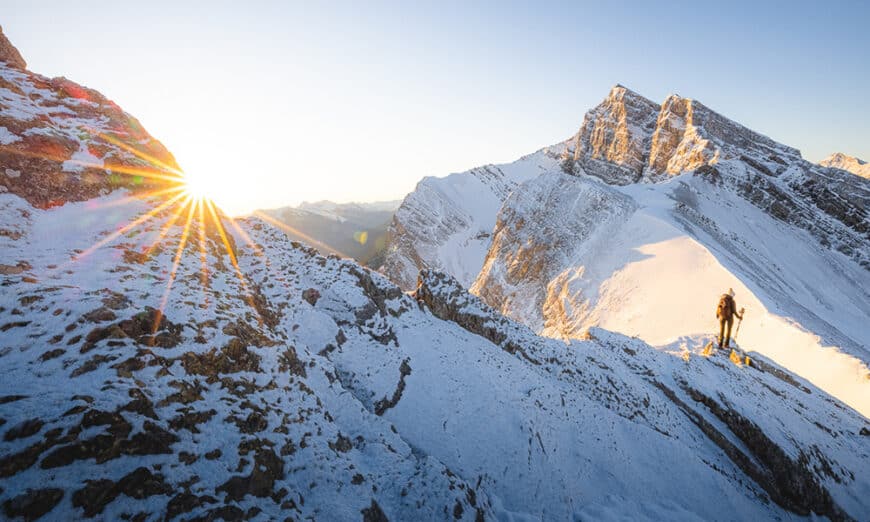
Taking in the sunrise from the top of Ha Ling Peak, Canmore, Alberta.
You just got back from a landscape photo shoot, uploaded the images to your computer, and they aren’t what you “pictured” you’d get. The photos are blurry, under or overexposed, and they lack the vibrant colours and sharpness you see all through the magazines and your Instagram feed.
Just remember that we have all been there at one point in our life, even the pros you see in the magazine. I promise you landscape photography becomes a lot more enjoyable once you get past this short phase.
I have put together five tips in this blog that I wish I knew when I first started. Save yourself the frustration and a ton of time, and read this to help improve your landscape photography today.
Five tips to improve your landscape photography today
1. Shoot RAW
RAW image files are large, uncompressed images stored on the memory card of a digital camera. JPEG images (what you may be shooting right now) are compressed files that limit the dynamic range and post-processing options.
With RAW files, you have more creative control, more colour data to work with, and of course, a better chance of recovering that blown-out, white sky that you accidentally overexposed.
On your camera menu, find where you can select your image quality. Switch it to “RAW” format, and then you’re set.

Canon camera menu
2. Invest in a Tripod
There is no such thing as a landscape photographer without their trusty tripod. When I got mine, I had a ton of fun in all the new creative shots I could take. Long exposures of waterfalls, moving streams, and of course, car light trails in the city.

Without my tripod, this shot of Banff would not have been possible with the 30-second shutter time.
The general rule of thumb for handheld shooting is not to go any lower than your lens focal length. So if you’re handheld shooting at 50mm focal length, you shouldn’t go any lower than 1/50 shutter speed. Going lower on your shutter often results in blurry images from your hand movement. This is where the tripod comes in.
With your camera securely placed on the tripod, you can now drop your shutter to as low as you want, without the need to turn up ISO to get a properly exposed shot. Say goodbye to ISO noise and blur in your photos.
You’re probably now wondering what tripod to buy. Here are a couple of my favourites below for you to check out.
My number one choice is the Manfrotto MT055CXPRO4 CF Tripod. If you’re a hiker, traveler, or carrying your gear far from the car, you’re going to want to invest in a carbon fibre setup like this to cut the weight.
This carbon fiber tripod is lighter than aluminum and will even absorb vibrations better. The 4-section leg design of this tripod will also save you space. Making it a great one to stuff into the suitcase or hiking backpack.
If you would like a budget-friendly recommendation, the Manfrotto Element Small Carbon Fiber Tripod is a great choice as well.
3. Use a Polarizer

I prefer screw-on Polarizers like this one pictured above. Make sure you get the right size for your lens.
Like polarized sunglasses, a polarizer removes glare from water, the sky, and any other shiny or reflective objects that may distract the eye. It can even add a pop of colour to a scene.
An obvious scene to put your polarizer on would be when photographing a lake and you’re trying to see the detail under the water. But don’t forget to put it on for scenes like a wet rain forest, waterfalls, or any other landscapes that include water or a distracting glare.
B+W makes excellent glass that won’t degrade your photos. If you’re looking for top-quality, this would be it – B+W 82MM Circular filter.
If you’re on a budget, Hoya also makes great polarizers that will get the job done. Here is one that I think you should take a look at – Hoya 82mm circular polarizer
4. Go Wide and Tight with Your Lens
Many people put way too much effort into researching the camera body then put little effort into the choice of lens. The lens has a massive impact on the image, more significant than your camera body, in my opinion.
The wide-angle lenses are the most popular pick for landscape photographers for a reason. The main point to shooting wide is it allows you to showcase the entire landscape with its large field of view. It also lets you get up close and personal with objects to exaggerate them in your composition, like a bunch of wildflowers, interesting rock formations, or a small tree.
Objects or people placed closest to the wide-angle lens will appear abnormally larger relative to the more distant objects. So I wouldn’t suggest trying to shoot any portraits at a wide focal length.
When it’s time to show off a landscape, my Canon 16-35mm 2.8 is my go-to. This focal range is guaranteed to get you unique perspectives and fit everything you need to in the scene.
Yes, this one isn’t cheap. But, it is going to last me for many years to come. Camera equipment also holds its value very well (if you’re nice to it), so when it comes time to upgrade, you have a head start if you sell your old equipment.
Henry’s Tip:
For mirrorless users, you can adapt this EF lens with a Canon mount adapter or try an RF lens instead. We recommend the Canon RF 15-35mm F2.8 L IS wide-angle zoom lens, which helps expand your field of view and is dust-, weather-, vibration-, and shock-resistant and features an 82mm filter diameter.
The Fujifilm 16mm F1.4 is another excellent lens that performs very well in low light. The 1.4 aperture will allow you to let more light in without dropping your shutter or cranking your ISO up, which can increase the noise and motion blur in your photographs, as discussed earlier. This lens has only one focal length, so you will have to manually zoom in or zoom out by moving closer to or farther from the subject!
5. Shoot at Golden Hour
When I first started, I thought a mid-sunny day shoot was the best lighting conditions for landscape photography. I couldn’t have been any further from the truth.
If you want dramatic photographs, beautiful contrasts of blue and orange in the sky, you need to shoot during golden hour. Golden hour is roughly one hour after sunrise and one hour before sunset.
If you have a sunrise shoot planned and you haven’t been to the location before, I always suggest showing up at least 30-minutes early. This gives you enough time to walk around, take some test shots, and get the creative juices flowing. This way, you will have found an excellent composition for when that light goes off because it happens fast.

Alpenglow lighting up the ridgeline.
Bonus Tips
For making it this far, here are some quick bonus tips!
- Add a human to your landscape scene somewhere to add a sense of scale to the scene.
- Use a wireless remote shutter button to avoid any camera shake during longer exposures.
- Get an ND Kit to add even more creative possibilities to your shots.
- Buy an extra memory card and stick it in your car or camera bag. Handy for when you forget to place yours back in the camera.
- Get a camera bag. Your gear is expensive; regular backpacks don’t protect it from a drop that could cost you thousands of dollars. I learned the hard way.
- Buy used camera gear to save money. Henry’s has a section for used gear where you can save a ton of money on your first setup.
Conclusions
I hope these tips have added some confidence and inspiration to the early stages of your landscape photography journey. Remember to be patient with your learning process and enjoy your time capturing the beauty of the outdoors.
What was your favourite tip? If you’re looking to continue with the knowledge, I recommend you check out this article about Exposure Compensation.
Henry’s Tip:
Visit your local Henry’s or live chat for more gear options to get you outfitted for your next big adventure!






COMMENT (1)
Pingback: Five Easy Tips To Improve Your Beginner Landscape Photography – Josh McCabe Photography